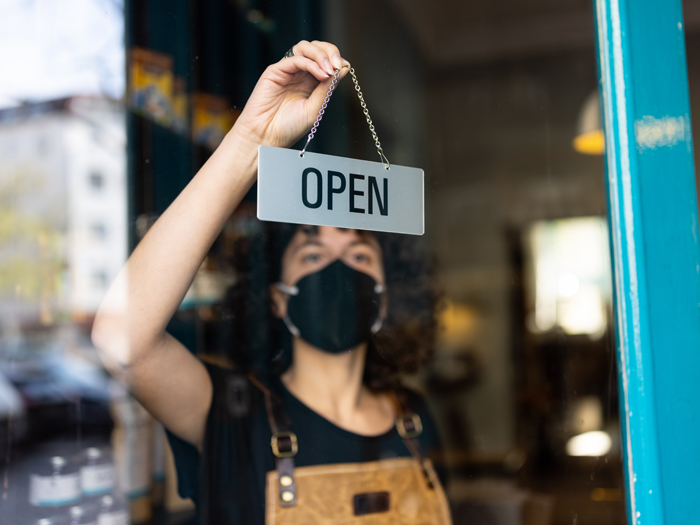Are Mid-Sized Companies Ready for Future Pandemics? Somehow, Many Still Don’t Have a Mitigation Strategy

Ask any mid-sized business leader, and you’ll likely hear about operating in one of the most challenging risk environments in recent history, particularly the direct and indirect effects of COVID-19 over the past two years.
Although COVID cases in the U.S. have eased of late, companies still need to have a plan for additional flare-ups. But many don’t.
QBE North America’s recently released Mid-Sized Company Risk Report showed that while COVID is on business leaders’ minds as an important risk, fewer than half (46%) of companies surveyed have a mitigation strategy for pandemic-associated risks.
Produced in partnership with the Association for Corporate Growth, the survey found that pandemic risks declined overall as a concern from the 2020 study, falling to the fourth highest “macro” risk.
This is a serious concern considering the potential for new, highly contagious COVID variants.
Research shows that the probability of novel disease outbreaks will increase three-fold over the next few decades and that there is a two percent probability of a pandemic with a similar impact to COVID occurring in any year.
With this reality in mind, it’s imperative that companies have business continuity plans and mitigation strategies in place when, not if, the next global health crisis occurs. Doing so can not only save the vitality of a business should an event occur, it can also be a competitive advantage.
What You Should Review for Your Future Pandemic Plans
1) One of the biggest concerns for a company in a pandemic is the health and safety of its people.

Bobby Steinsdoerfer, senior vice president, property & casualty, QBE North America
Organizations should note which employees are considered essential in-office workers and strategize ways to protect them while on the job. This can include providing personal protective equipment, setting up contact tracing protocols and quarantine procedures that meet or exceed government suggestions, and establishing designated workspaces for each person when applicable, as well as reorganizing the office space and improving indoor air quality.
2) Ensuring that customers and clients are also healthy is another major part of the mitigation strategy.
Businesses should implement cleaning strategies that ensure public spaces are kept clean as well as follow any masking and social distancing guidelines from authorities. Businesses can also provide customers and visitors to their buildings with masks, as well as have hand sanitizer stations set up throughout the workplace.
3) Cybersecurity related to remote work is another a top concern for mid-sized businesses when it comes to future pandemic worries.
Remote employees leave companies open to cyber risks, emphasizing the need for airtight cybersecurity measures, even when workers aren’t virtual.
Businesses should ensure they have a cybersecurity team in place to monitor exposures, as well as training modules and workshops to teach employees how to be cyber safe both in the office and at home.
It’s best for these practices to be implemented in tandem with cybersecurity standards and other measures such as virtual private networks and two-factor authentication. Organizations should also consider whether they approve of employees using their personal devices for work or if they prefer employees to use company devices.
Businesses should also establish transition procedures such as a system for how employees can collect their in-office equipment or get it shipped to their home, and protocols for transferring, moving and storing company data that is needed to work at home.
4) A review of the supply chain can never hurt for future risk mitigation efforts.
As we have seen over the last two years, a pandemic can disrupt the supply chain for businesses and greatly hinder operations. Therefore, a pandemic risk mitigation plan should consider supply chain vulnerability.
The strategy could include using multiple, geo-graphically dispersed suppliers instead of just one. Multi-sourcing allows businesses to keep operating if their main supplier is unable to meet demands and mitigates potential supply chain bottlenecks.
5) A pandemic could force changes to a company’s business model to stay solvent.

Jennifer Clough, assistant vice president, risk solutions, QBE North America.
For instance, many restaurants added delivery of prepared meals during the pandemic. This change added a new set of hired and non-owned auto exposures that businesses needed to consider. A robust mitigation plan would include practices to minimize and insure against potential exposures related to operational shifts.
6) Finally, even if most or all employees cannot come to the workplace, it’s critical that companies still maintain the physical location.
Many risks increase due to vacancy, including break-ins, burst pipes, fires, gas leaks, icy sidewalks, falling ice, to name a few.
Staff turnover or layoffs could degrade the effectiveness of Fire Protection Impairment programs for vacant or idle buildings.
Businesses should have maintenance and security plans that include keeping heating and air conditioning on, regularly checking the property, and a recurring inspection schedule to ensure the building remains safe and ready for workers to return.
Staying Vigilant
The pandemic continues, and it’s easy to let our guard down as we ease back into our old ways. But it doesn’t mean another flareup can’t and won’t occur.
Staying vigilant in processes and planning can make all the difference for businesses should any major interruption come their way. &










